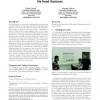Free Online Productivity Tools
i2Speak
i2Symbol
i2OCR
iTex2Img
iWeb2Print
iWeb2Shot
i2Type
iPdf2Split
iPdf2Merge
i2Bopomofo
i2Arabic
i2Style
i2Image
i2PDF
iLatex2Rtf
Sci2ools
PETRA
2015
ACM
2015
ACM
Nonverbal communication with a humanoid robot via head gestures
Social interactive robots require sophisticated perception and cognition abilities to behave and interact in a natural humanlike way. The proper perception of behavior of interaction partner plays a crucial role in social robotics. The interpretation of these behaviors and mapping them to their exact meanings is also an important aspect that interactive robots should have. This paper proposes an interaction model for communicating verbally and nonverbally with human. Human behavior, during the interaction with the robot, is perceived and then interpreted depending on the situation in which the behavior has been detected. In this model, head gestures are used as a back channel (feedback) for the robot to adapt the interaction scenario. The back channel signals can be consciously or unconsciously generated by human. Simultaneously, the eye gazes are also detected to ensure right interpretation of head gestures. In order to recognize the human head gestures, head poses have been tracked ...
Related Content
| Added | 16 Apr 2016 |
| Updated | 16 Apr 2016 |
| Type | Journal |
| Year | 2015 |
| Where | PETRA |
Comments (0)

